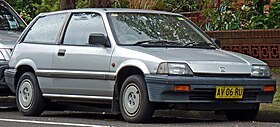Honda Civic (third generation)
| Honda Civic Third generation (AG/AH/AJ/AK/AT/AU) |
|
|---|---|
 |
|
| Overview | |
| Manufacturer | Honda |
| Production | September 1983–September 1987 |
| Assembly |
Suzuka, Japan Alliston, Ontario, Canada (HCM) Hsinchu, Taiwan, ROC South Africa Nelson, New Zealand (Honda New Zealand) Johor Bahru, Malaysia (OASB) |
| Designer | Yoshio Ui, Tsuyoshi Nishimura, Osamu Akimoto (1981) |
| Body and chassis | |
| Class | Subcompact |
| Body style | 3-door hatchback/kammback 3-door coupé (CRX) 4-door sedan 5-door station wagon (Shuttle) |
| Layout | Front engine, front-wheel drive / Four-wheel drive |
| Related |
Triumph Acclaim Rover 200 Honda CRX Honda Ballade Honda Quint Honda/Acura Integra |
| Powertrain | |
| Engine | |
| Transmission | 4/5 speed manual 5+1 speed manual 4WD 3 speed Hondamatic automatic 4 speed Hondamatic automatic |
| Dimensions | |
| Wheelbase | 94 in (2,388 mm) (hatchback) 96 in (2,438 mm) (sedan) |
| Length | 150 in (3,810 mm) (hatchback) 164 in (4,166 mm) (sedan) |
| Width | 64 in (1,626 mm) |
| Height | 53 in (1,346 mm) (hatchback) 55 in (1,397 mm) (sedan) |
| Chronology | |
| Predecessor | Honda Civic (second generation) |
| Successor | Honda Civic (fourth generation) |
The third generation Honda Civic is an automobile which was produced by Honda from 1983 to 1987. It was introduced in September 1983 for model year 1984. The Civic's wheelbase was increased by 2–5 inches (13 cm) to 93.7 inches (hatchback) or 96.5 inches (sedan). A three-door hatchback/kammback, four-door sedan (also known as the Honda Ballade), the five-door "Shuttle" station wagon, and sporting CRX coupé shared common underpinnings. This included MacPherson strut suspension with torsion bars in the front and a rear beam with coil springs. However, the body panels were largely different between models. The Civic-based Honda Quint five-door hatchback also underwent a model change, and became the Honda Quint Integra, available as both a three- and five-door fastback. The Quint Integra (soon just "Integra") was sold at the Japanese Honda Verno dealership along with the CR-X. The Civic in Japan was now exclusive to Honda Primo, along with Honda's kei cars as well as superminis like the Honda City.
At its introduction in 1983, it won the Car of the Year Japan Award.
The sedan and hatchback shared the same dashboard, but the CRX and wagons both had their own unique dash (CRX having a covered cubby in the middle of the dash, the wagon having a pop up set of vents which could be used or retracted into the dash). The hatchback adopted a flatter roof over the rear seats, drawing influences from a bodystyle known in Europe as a shooting-brake, that seemed to blur the definition between traditionally defined hatchbacks and the shooting-brake. The flat roof, three door hatchback appearance was also used on the supermini Honda City, and the Honda Today, the car that returned Honda to kei car production. This appearance was also used on the Honda Accord Aerodeck. The Honda CR-X was the only three-door hatchback that adopted a fastback, sloping rear hatch, demonstrating a performance car appearance identified with Honda Verno products during the mid-1980s. In Europe, a British-built version of the sedan model was also sold, as the Rover 213/216, while in Japan it was marketed in parallel (through "Verno" dealers) as the Honda Ballade. Both the Sedan and Hatchback models were also sold in Indonesia under the name Civic "Wonder".
...
Wikipedia
